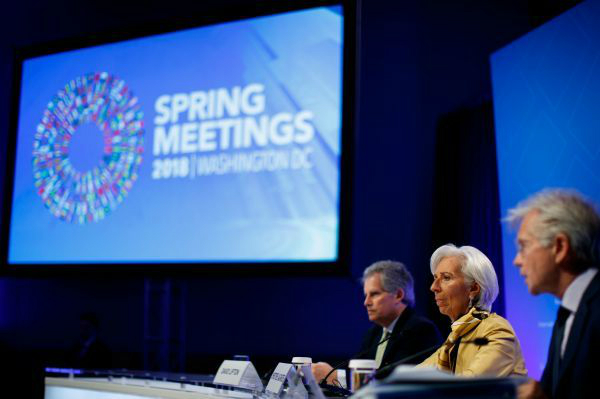World economic growth faces constraints

The IMF downgraded its global economic growth forecast to 3.7 percent for 2018 and 2019, 0.2 percentage points lower for both years than in its forecast in April. Photo: XINHUA
The International Monetary Fund (IMF) downgraded its global economic growth forecast to 3.7 percent for 2018 and 2019 in its newest World Economic Outlook report, 0.2 percentage points lower for both years than in its forecast in April. The decrease is a result of mounting trade tensions, according to the report. In this interview, economists agree that the world economy is expanding at a moderate speed as structural factors continue to hold back global growth in the long run. Also, China is expected to contribute to better prospects.
Rei Tsuruta, a researcher from the Department of Business Planning at Japan’s MUFJ Bank, said that the economies of developed and emerging markets keep expanding, so the momentum of global economic growth will be sustained in the near future.
There was sufficient faith in the world economy as the growth rate experienced an increase from the second half of 2017 till the first half of this year. IMF’s downward revision reflects the existence of unstable factors that hurt the global economy, said Zhang Yuyan, director of the Institute of World Economics and Politics at the Chinese Academy of Social Sciences.
The world economy is reviving, but its growth pace is slowing, said Katsuyuki Hasegawa, chief economist of Japan’s Mizuho Research Institute, adding that the United States has consistently increased protectionism, making it difficult for the global economy to thrive. Also, it is hard to believe that the US economy is immune from the negative effects.
The increased tariffs imposed by the United States have impacted international trade and dented the global economy. The result can be seen in the higher price of imported goods, especially those that are difficult to substitute, which in turn will affect overall pricing trends, said Xia Huasheng, a researcher at the Brazilian think tank FGV. Inflation is just around the corner if this upward trend reaches bulk commodities, labor markets and the cost of living. However, when central banks raise interest rates, economic activity will become weaker, thus holding back global trade again.
At present, a major characteristic of the world economy is the difference in economic performance between developed countries and emerging markets.
“Under the tax cuts and expansionary fiscal policies, the US economic fundamentals are improving in the short term, but its economic growth is unsustainable,” Zhang said. The US fiscal deficit has once again hit a record high, and it is expected to continue to rise in the future. Additionally, the growth rate of the US economy outpaces its potential growth, so its economic growth cannot be sustained. The Fed predicted the potential growth rate of the US economy to be 1.8 percent, well below the current 3.8 percent, Zhang added.
In Europe, economic growth is still bottlenecked. The GDP of the 28 EU members in the third quarter increased by 0.3 percent on the previous quarter, down from 0.5 percent, according to Eurostat preliminary data.
Zhang pointed out that the long-term endogeneity of economic growth in Europe hasn’t been solved, and the labor productivity there has stagnated. “With the tightening global economy and market demand, the EU’s persistent loose fiscal policies and monetary policies have failed to have major effects, putting economic growth on hold.”
People need to follow the Brexit negotiations and Italy’s budget crisis, because these issues may cause financial markets to fluctuate and may deteriorate economic prospects, Tsuruta said.
The economic outlooks for some emerging markets and developing countries such as Iran, Turkey, Argentina and Brazil are bleak due to multiple factors, such as national circumstances, tightened financial environments, geopolitical tensions and higher oil import prices. However, a host of energy exporting countries have benefited from rising oil prices. Tsuruta said that the US financial policy normalization has driven capital from emerging markets into the United States, leading to volatile financial markets in Turkey and Argentina, who rely heavily on policy and have a weak ability to resist external changes. Zhang believed that the IMF and other global organizations have improved the situations in these countries, but if the United States adjusts monetary policy in the future, then the global exchange rate will suffer further impacts.
The Chinese economy is heading towards a high-quality development pattern, which has taken the spotlight on the global stage. In the first half of 2018, China received the most foreign direct investment (FDI) against the backdrop of a 41 percent plunge in global FDI, according to statistics by the United Nations Conference on Trade and Development.
What Tsuruta particularly valued is that the Chinese economy not only has traditional state-owned enterprises, but also other dynamic economic forms dominated by private businesses. He said that in the future, it is important to connect business vitality with economic growth through boldly opening markets, passing regulatory reforms and giving full play to the vigorous private sector.
It is Zhang’s view that China’s economic structure has shifted from being labor-oriented to being technology-oriented due to the increase in labor cost, triggering a certain amount of market pressure. “Enterprises must invest in technology to survive. New technology doesn’t necessarily mean technological innovation. It can be achieved by reorganizing existing technologies to improve labor productivity,” Zhang said.
This article was translated from People’s Daily.
(edited by MA YUHONG)
